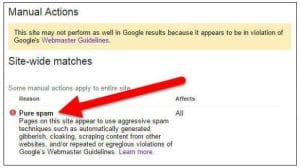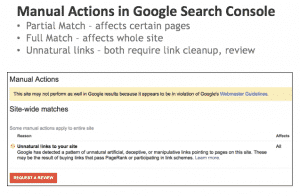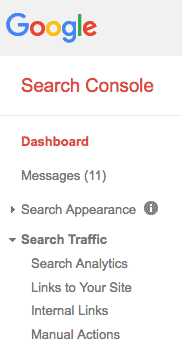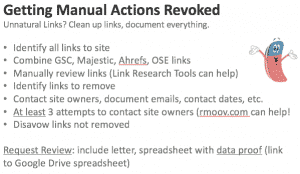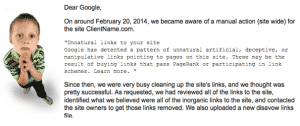Do you think you have a Google penalty? Has the traffic from organic search to your website gone down dramatically? One indication that your website may be suffering from a Google penalty or manual action type of penalty from Google is a severe drop-off in traffic. Typically, this means that one day your website is doing well–and literally the next day it is not, sometimes only 10 percent of what it was the day before. A dramatic loss of organic, natural search traffic, overnight, can mean that you have a Google penalty. Bill Hartzer offers a Google penalty recovery service, to recover lost traffic from organic search.
Understanding Google Penalties
There are generally two main types of Google penalties: algorithmic penalties and manual actions. Algorithmic penalties are penalties where you must fix the issue, and you cannot ask Google to review the issue once it’s fixed.
- Manual Actions and Manual Google Penalties – Manual actions or manual penalties require that you fix the issue, then you must ask for reconsideration. You must officially file, as a verified website owner, a reconsideration request with Google. Once they review your request, they will manually review it. If you’ve cleaned up and fixed the issue, they may lift the Google penalty.
- Algorithmic Penalties – Google’s search engine algorithm is really sophisticated: it can spot certain website design issues and search engine optimization issues that can get a website penalized. For example, having text on your website that’s hidden will get your website algorithmically penalized. A specific example of this would be having white text on a white background, text that humans generally cannot see, but the search engine can see. Your website is hiding text, so, depending on the amount of frequency of hiding text, it could lead to an algorithmic penalty by Google. In order to get an algorithmic penalty removed, you first need to identify the penalty. Then, you need to fix the issue. After it’s fixed, you need to wait until Google crawls the web page or website again, and wait for the algorithm to catch up and review the issue. That all takes time.
Even though there are “only” two types of Google penalties, there are literally hundreds of different scenarios and issues that can cause your website to be penalized. There are two different classes of penalties: on-site or on-page penalties, and off-site or off-page penalties. Your website is doing something that’s against Google’s acceptable webmaster guidelines (the way it’s been programmed or designed). Or, something has been done that’s not on your website that is causing the penalty. A good example of this would be something like paid links that are not disclosed that they’re paid.
Is your website pure spam?
In the case of the screen shot above, at the top of this page, this is an example of a manual action by Google. In this case, it’s an on-page or on-site penalty. Google thought that the website had a lot of spam on it–so much nonsensical content that was being used to manipulate their search results that Google penalized the whole entire website, calling it “pure spam”. However, it turns out that this was not just an open-and-shut case of removing the content from the website. In fact, the pure spam content never actually existed on the website and was not put on the website by the current website owner.
These google penalties can be extremely complex, and even many search engine optimization professionals would never know what to do in this situation. It turned out that my Google penalty recover service would have spotted this issue almost immediately, because I have personally been doing this so long. Learn more about this extremely complex manual action from Google levied against a very well-known news outlet, ZDNet. I personally helped this website recover from this manual action by talking to representatives from ZDNet on Twitter, guiding them in the right direction. In this case, ZDNet bought a domain name and their new website was immediately banned in Google, given a manual action penalty.
How to Identify a Google Penalty
One of the most difficult issues to deal with when you think you have a search engine penalty is actually identifying the penalty itself. There are several ways to start identifying the search engine penalty, and, in fact, there actually could be multiple search engine penalties. Whatever the case, though, the first thing I recommend that you do is verify your website with Google, in Google Search Console. Then, follow these steps:
- Log into Google Search Console.
- Select your website.
- Navigate to the Manual Actions link, as shown below:
Once you click on the manual actions link, you will see the status of any penalties.
- If you have a manual action, then the penalty will be shown. You can review the penalty. If you don’t understand it, then get in touch with me and I will explain it to you at no charge.
- If you do not have a manual penalty from Google, then you’ll see a message like this:
If you have no manual webspam actions, or see that message there, that doesn’t mean that your website isn’t suffering from a search engine penalty. In fact, it only get tougher to diagnose the penalty if you have no manual action.
- Go check every version of your website for a manual action. You will have to verify all versions of your website in Google Search Console in order to do this. This means verify these versions:
- https://
- https://www
- http://
- http://www
There are four versions of your website, and if you have a subdomain (such as whatever dot yourdomain dot com), then ‘whatever’ will have four versions, as well. You need to manually check those, as well, after you’ve verified them in Google Search Console. The reason is that you can have a manual action on one version or one subdomain on your website, and that can affect just a few pages of your website or it can actually affect the whole entire website, depending on the penalty.
If you do NOT have any manual actions, then it gets tougher to diagnose the actual penalty (or multiple penalties). Only someone who intimately knows the Google Webmaster Guidelines, website code, and the intricacies of SEO can properly diagnose Google penalties, whether manual or algorithmic.
Teaching Other SEOs about Google Penalties
For the past several years, as an SEO speaker, I have personally taught hundreds of other SEO professionals about Google penalties, Google manual actions, and how to properly file reconsideration requests with Google. Literally, other SEO firm owners have gotten on a plane and flown here to Dallas to meet with me. They have paid me (and the digital marketing agencies I work for) thousands of dollars to teach them one-on-one on how to recover from link penalties, manual actions, and properly file reconsideration requests with Google.
I’ve spoken at many search industry conferences about Google penalties, and offered by Google penalty recovery service to lots of website owners over the years, including PubCon, SMX, SMX Advanced, ClickZ Live, Search Engine Strategies, and Digital Summit. I currently run Digital Search Summit. There are very specific ways, and very specific tasks that you must complete, in the proper order, in order to recover from a Google manual action. I have, multiple times, taught others (my peers) about how to file reconsideration requests, and how to recover from a Google manual action or Google penalty.
How to Recover from a Google Penalty
As I mentioned, the tough part of all of this is to first identify the problem, identify the specific penalty. Once you have done that, if it is a manual action from Google, there are several steps to take to recover. Google’s manual actions are a pretty big deal: you must tell Google that you understand what you’ve done, and then you need to tell them that you have fixed the issue. Then, beg, plead, and tell them that you will never, ever, do it again. Pink Promise type of swear. OK, well, I’m exaggerating here. But seriously, you have to beg, plead, and tell them that you will never, ever, do it again. I’m only kidding on the Pinky Promise part.
There was one particular case a while back where I was working on a Google manual penalty. This real estate website had over 100,000 backlinks to their website, and literally about 25 percent of those backlinks were super low quality, toxic, spam links. They had generated or gotten those links just in order to rank well in Google. The links themselves were from horrible, low quality, computer generated websites, such as spammy link directories, listings of websites on websites, spam comments on blogs, and social bookmarking web 2.0 type links. I literally had to get thousands upon thousands of links removed from other websites. After getting about 10,000 links removed, I filed a reconsideration request with Google, using Google’s form. A few days later, Google got back with me, telling me that I needed to remove even more links, as the Google Penalty they were leveraging on this website was so bad that they needed to get rid of more bad links. Two rounds of reconsideration requests later, I finally got the Google manual action lifted, and 25,000 links were removed.
Getting Link Manual Actions Revoked
Do you have unnatural links pointing to your website from other websites? First, you absolutely have to clean up the links, and document everything.
- Identify all links to site
- Combine Google Search Console, Majestic.com, Ahrefs.com, Open Site Explorer links
- Manually review all links (Link Research Tools can help)
- Identify the links to remove
- Contact website owners, document emails, contact dates, etc.
- Make at least 3 attempts to contact website owners (rmoov.com can help!
- Disavow all of the links you have not gotten removed.
- Request Review, file a reconsideration request with Google. Include a letter, a spreadsheet with data proof (link to a Google Drive spreadsheet with this information).
Filing a reconsideration request with Google is important–and you need to do it in such a way that you explain everything. What I have seen is that people have just disavowed links when they have a link manual action. That won’t work. I have even seen people file the reconsideration request without doing anything. Then, even worse, I have seen website owners fill out the reconsideration request for multiple times, just annoying Google employees. Every manual action is manually reviewed by a Google employee: and they get over 5,000 reconsideration requests a week!
Filing a Google Reconsideration Request
There is only one time, as I mentioned, that you need to file a reconsideration request: when you’ve fixed what your website was doing or when you have cleaned up everything. Or removed bad links if it’s a link penalty. Here are some suggestions:
Google wants to know that you suffered in order to clean up links if, for example, you had a link penalty.
- Prove to Google that you went above and beyond to clean up links.
- Provide spreadsheet with status of every link, and emails.
Here is an example of a reconsideration request that I successfully filed with Google regarding a links-related manual action (Google manual penalty for having bad links to a website).
I don’t recommend that you use that actual text in the graphic above, you need to tailor the request to Google to your particular situation. As you can see, though, and as I mentioned here, Google penalties can be really complex, and they can even involve several penalties all at once. If you do the Google penalty recovery the wrong way, then you can actually make matters much worse, and even more difficult to recover from a search engine penalty. That’s exactly why you need an experienced Google penalty service expert, such as myself.
Google Penalty Recovery Service
As I mentioned earlier, even though there are “only” two types of Google penalties, there are literally hundreds of different scenarios and issues that can cause your website to be penalized. You need someone like myself, someone who has literally been doing search engine optimization way before Google even came into existence, to help you. In the past 10 years alone, I have personally handled a LOT of Google penalty recoveries. I’ve helped a LOT of websites with manual actions (called Google manual penalties), and successfully resolved every single penalty that I have ever been involved with. As an SEO consultant, I provide a lot of search engine optimization services related to Google penalties, including:
- Google penalty recovery service
- Google link cleanup service
- Website cleanup services – related to Google Penalties
- Website spam removal
- Website malware removal
- Recovery from a hacked website
During the process of recovering from a search engine penalty, the most difficult part is identifying the actual penalty. I cannot provide you with a proper Google penalty recovery service if we don’t know that the penalty is. I first take the time to manually look at the website, review all of the links to your website, and even review other information such as your website analytics data. Only then, I can get an idea about what your penalty is about, why your website traffic is down, and what we can do about it. The best news, though could be that your website isn’t suffering from any Google penalties.
Keep in mind that once your Google penalty is actually removed, and Google has revoked a manual action that they’ve given your website, it will take time to recover lost search engine traffic. How long it takes to recover depends largely on the type of Google penalty that has been given to your website.
